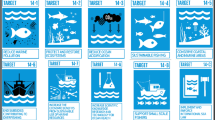Abstract
The World Water Vision report launched in 2000 by the World Water Commission for the twenty-first century described four scenarios for the future of water resources; three of these were quantified. The fourth was a qualitative scenario or vision that showed how a viable change in our practices involving solution elements of the other three scenarios could lead to securing access to safe water supplies for the world population by 2025. Fourteen years later, the status of water quality and availability around the world has led experts to point to a global water crisis: the world is further from the 2025 Vision than in 2000. In this article, the co-authors – including the Vision’s co-author – identify some of the reasons why the foresight effort did not herald the expected change, and look to how current water foresight initiatives are seeking to further narrow the gap with stakeholder needs.

Similar content being viewed by others
Notes
The first formal round of Shell scenarios was completed in November 1971. Since then Shell’s scenario planners have produced 34 rounds of global and long-term energy scenarios and updates and many more-focused ones.
References
Alcomo, Joseph and Gilbertp Gallopín (2009) Building a 2nd Generation of World Water Scenarios. Paris: United Nations World Water Assessment Programme/UNESCO.
Allan, Tony (2001) The Middle East Water Question – Hydropolitics and the global economy. London: I.B. Tauris & Company.
Bourgon, Jocelyne (2008) ‘The future of public service: A search for a new balance’, Australian Journal of Public Administration 67(4): 390–404, as cited in Derek Gill, Stephanie Pride, Helen Gilbert and Richard Norman, ‘The Future State’, Institute of Policy Studies Working Paper 10/08, May 2010, Wellington, NZ: Institute of Policy Studies – School of Government – Victoria University of Wellington.
Chi, Keon S. (1991) ‘Foresight Activities in State Government’, Futures Research Quarterly 7 (4): 47–60.
Chi, Keon S. (2008) State Governance Transformation: Why and how. Lexington, KY: Council of State Governments.
Cosgrove, William J. (2013) ‘Water Futures: The evolution of water scenarios’, Current Opinion in Environmental Sustainability 5 (5): 559–565.
Cosgrove, Catherine E. and William J. Cosgrove (2012) The Dynamics of Global Water Futures: Driving forces 2011–2050. Paris: UNESCO.
Cosgrove, William J. and Frank R. Rijsberman (2001) ‘The Making of the World Water Vision Exercise’, in Frank R. Rijsberman (ed.) World Water Scenarios: Analyses. London: Earthscan.
Cosgrove, William J. and Frank R. Rijsberman (2000) World Water Vision: Making water everybody’s business. London: Earthscan.
Dahle, Kjell (1999) ‘Towards Responsibility for Future Generations: Five possible strategies for transformation’, in Tae-Chang Kim and James A. Dator (eds.) Co-Creating a Public Philosophy for Future Generations. Westport, CT: Praeger.
Florini, Ann (2003) The Coming Democracy. Washington DC: Island Press.
Gallopin, Gilberto (2012) Five Stylized Scenarios. Paris: UNESCO.
House of Commons (2007) Governing the Future: Second report of session 2006–2007. Volume 1. Public Administration Select Committee. London: The Stationery Office.
IPCC (2013) Climate Change 2013: The physical science basis. Contribution of Working Group I to the Fifth Assessment Report of the Intergovernmental Panel on Climate Change [Thomas F. Stocker, Dahe Qin, Gian-Kasper Plattner, Melinda Tignor, Simon K. Allen, Judith Boschung, Alexander Nauels, Yu Xia, Vincent Bex and Pauline M. Midgley (eds.)]. Cambridge, UK and New York, USA: Cambridge University Press, pp. 1535.
Mackie, Thomas T. and Brian Hogwood (1984) ‘Decision Arenas in Executive Decision Marking: Cabinet committees in comparative perspective’, British Journal of Political Science 14 (3): 285–312.
Shiklomanov, Igor A. (1998) World Water Resources. Paris: UNESCO.
UNESCO (2009) 3rd United Nations World Water Report: Water in a changing world. Paris: UNESCO.
UNESCO (2012) 4th United Nations World Water Report: Managing water under risk and uncertainty. Paris: UNESCO.
Wilkinson, Angela and Roland Kupers (2013) ‘Living in the Futures: How scenario planning changed corporate strategy’, Harvard Business Review 91 (5): 119–127.
WWAP (United Nations World Water Assessment Programme) (2014) The United Nations World Water Development Report 2014: Water and energy. Paris: UNESCO.
Xu, Chong-Yu and Vijay P. Singh (2004) ‘Review on Regional Water Resources Assessment Under Stationary and Changing Climate’, Water Resources Management 18 (6): 591–612.
Further readings
Jacobs, Katharine (2002) Connecting Science, Policy, and Decisionmaking: A handbook for researchers and science agencies. Washington DC: Office of Global Programs, National Oceanic and Atmospheric Administration.
Cosgrove, William J. (2009) ‘Public Participation to Promote Water Ethics and Transparency’, in Llamas. M. Ramón, Luis Martinez-Cortina and Aditi Mukherji (eds.) Water Ethics. London: CRC Press – Taylor and Francis.
Additional information
Reflects on why the World Water Vision process of 2000 did not have the intended impact and how current water foresight processes are learning from this experience




